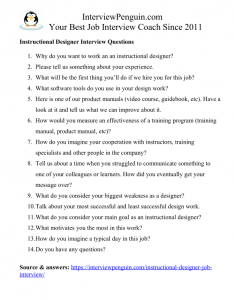Learning forms an integral part of our life. Students, employees, product and software users–all of them work with different kinds of study materials. Books, online platform, video courses, interactive learning applications, product manuals, and so on. Instructional designers prepare the materials, and hence they play an essential role in education of everyone of us. You made a good career choice. In this article we will look at some questions you may face in your interview, and give you an advice on how to answer the questions. Enjoy!
Table of Contents
Why do you want to work an an instructional designer?
You should not refer to your degree, or to anything else that would indicate a must to apply for a job. Try to talk about your passion for design, skills that make from you a good candidate (ability to design interactive appealing educational materials, artistic skills, experience in the field), the bright future of the profession, etc.
You can also say that you see a meaningful purpose in your work–after all no education would be possible without educational materials–without the work of instructional designers.
Try to talk with enthusiasm about your career choice. They should get an impression that you really want to do the job.
Please tell us something about your experience.
You probably did your research and already know what sort of designs you will work on in your new job. Now you should take your professional work portfolio out of your briefcase (or open it on your laptop, if you have it in a digital form), and show them either the most relevant designs (similar style, concept, topic of what you’d design in your new job), or your best works.
You can use this opportunity to mention different software tools (or even programming languages) you used while working on each design. You can also tell them a short story of each design project (target audience, purpose of training, goals you set, process of design, final work, evaluation).
Again, try to talk with enthusiasm about your design projects. Doing so, you can easily make them enthusiastic about your job application, about a prospect of having you onboard.
What will be the first thing you’ll do if we hire you for this job?
Obviously this depends slightly on your place of work, audience for your training materials, and also the organizational structure of the company or public institution. You may cooperate with training specialists and with other designers or even with programmers, but you can be also the lone wolf and respond for everything.
In any case, you can say that you will try to understand your place within the company, the training needs of your audience, the expectations of your managers.
This should help you to create a plan and to start working on new instructional materials or redesign existing materials (either alone, or together with your colleagues, depending on the organizational structure).
What software tools do you use in your design work?
Instead of just blindly listing the tools–most of which your interviewers may not even know–you should always explain (briefly, with one sentence) when or why you use each particular tool/application, how it helps you in your work.
For example, you use Camtasia for screen recording, editing, and adding effects, since it is simple to use and allows you to create sappealing training videos in a matter of minutes.
To popular SW tools for instructional designers belong: Adobe Captivate, Lectora, SnagIt, Brainshark, Easygenerator, and many others.
Tools aren’t necessary but they make your work easier and more effective. Ensure the interviewers that you understand the benefits, and that you continue discovering new software tools and apps that can help you in your work.
Here is one of our product manuals (video course, guidebook, etc). Have a look at it and tell us what we can improve about it.
You can face two scenarios at the point. The first one is when you cannot spot any apparent flaw in the presented training material.
In such a case, you should say that you prefer data-driven decision to first impression, that you would need to talk to the learners to see whether the material is easy to understand for them, whether it meets the purpose (they learn the desired skill), and just then you’d be able to evaluate the materials and find areas for improvement. Or you’d suggest redesigning it completely.
Second scenario is when you can spot some apparent flaws–lack of graphics, difficult language (technicalities an average user/student won’t understand), voice over is hard to understand, the design is outdated and does not match with the modern product or expectations of the learners, etc.
In this case you should not hesitate to point out the areas for improvement. That’s the reason they want to hire you, after all— to improve their existing instructional materials.
How would you measure an effectiveness of a training program (training manual, product manual, etc)?
The best answer is saying that you start each design work with a set of goals you want to achieve. The goals should always relate to the final user (student, customer, employee, etc), and you should be able to evaluate your results in some time.
Example: You design online tutorials for a web hosting company. The graphic and video tutorials should help the final users address ten most common simple hosting issues on their own, without a need to open a support ticket with the host.
Of course, not everyone will understand the tutorials and some people will still open support tickets, but a realistic goal can be that 90% of users will manage to solve the problems with the help of your tutorials, and won’t contact the host for help.
You can easily evaluate such a goal on a monthly, quarterly, or yearly basis…
How do you imagine your cooperation with instructors, training specialists and other people in the company?
Your goal is to convince the hiring managers that you want to cooperate with your colleagues, virtually on a daily basis. Instructors will teach the students with the help of your materials. It is crucial that they understand the materials, and you should ensure about it while consulting them regularly.
What’s more, they can give you feedback from the students (parts of the course they struggled with or found boring), which helps you to improve the materials, to better your design works.
Training specialists can help you with identifying training needs, and also with the choice of appropriate form of training materials (graphics, video, interactive app, etc), since they have direct contact with the learners and are experts in understanding their needs and preferences.
Ensure the hiring managers that you are a team player, and understand the value your colleagues can bring to your work, and vice versa.
Other questions you may face in your instructional designer interview
- Tell us about a time when you struggled to communicate something to one of your colleagues or learners. How did you eventually get your message over?
- What do you consider your biggest weakness as a designer?
- Talk about your most successful and least successful design work.
- What do you consider your main goal as an instructional designer?
- What motivates you the most in this work?
- How do you imagine a typical day in this job?
- Do you have any questions?
* You can download the full list of questions in a one page long PDF, print it, and practice your interview answers anytime later:

Conclusion and next steps
Instructional design is a fascinating field that evolves quickly with the help of intuitive software tools, machine learning and artificial intelligence. The career is getting more popular in recent years, and it may easily happen that you compete with ten other people for the job.
Your success (or failure) is not a question of luck, however. Prepare for the difficult questions you may get, improve your work portfolio, and do some research about you prospective employer (especially their design works, if you can find any). I hope you will succeed and with you good luck!
Matthew
May also interest you:
- Interior Designer interview questions.
- Graphic Designer interview – Tell me about yourself.
- Presenting your work using PowerPoint – How to present your work in an interview with a help of PowerPoint presentation.


